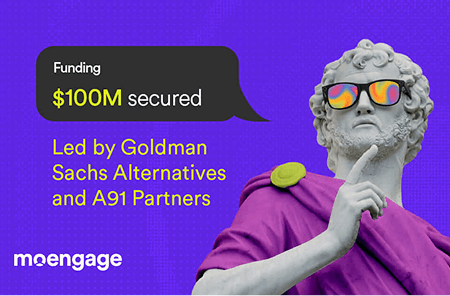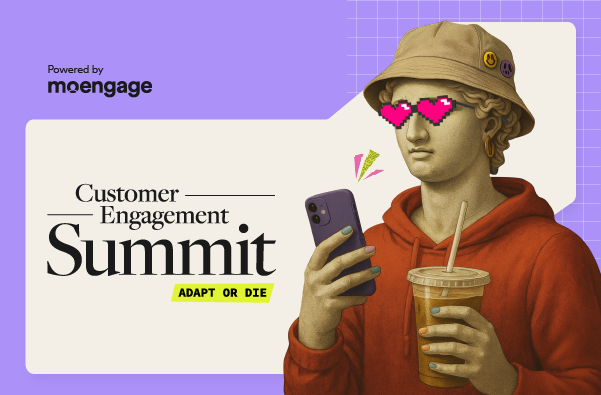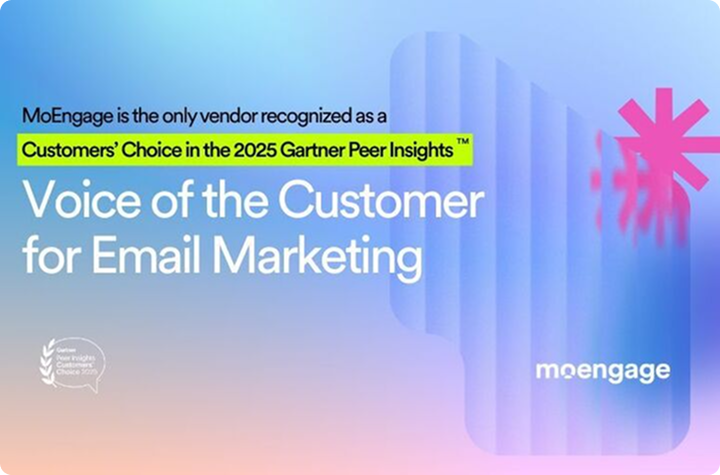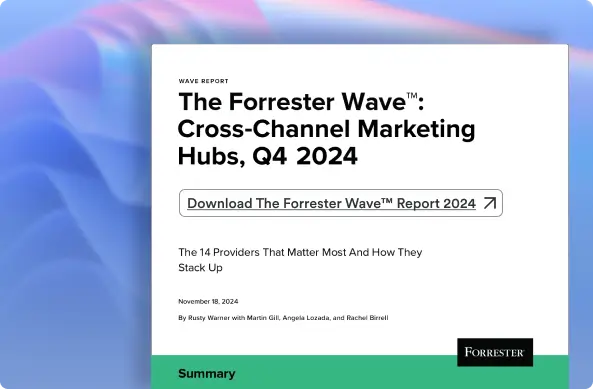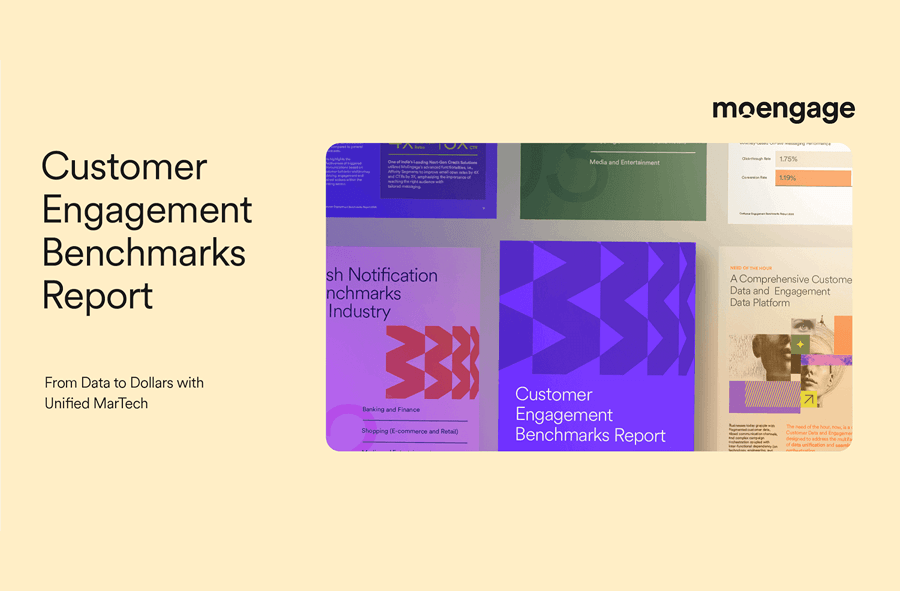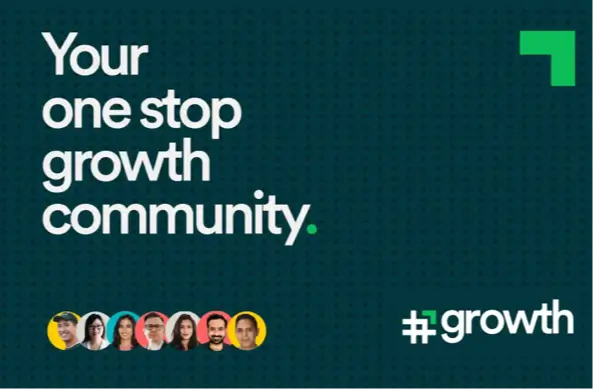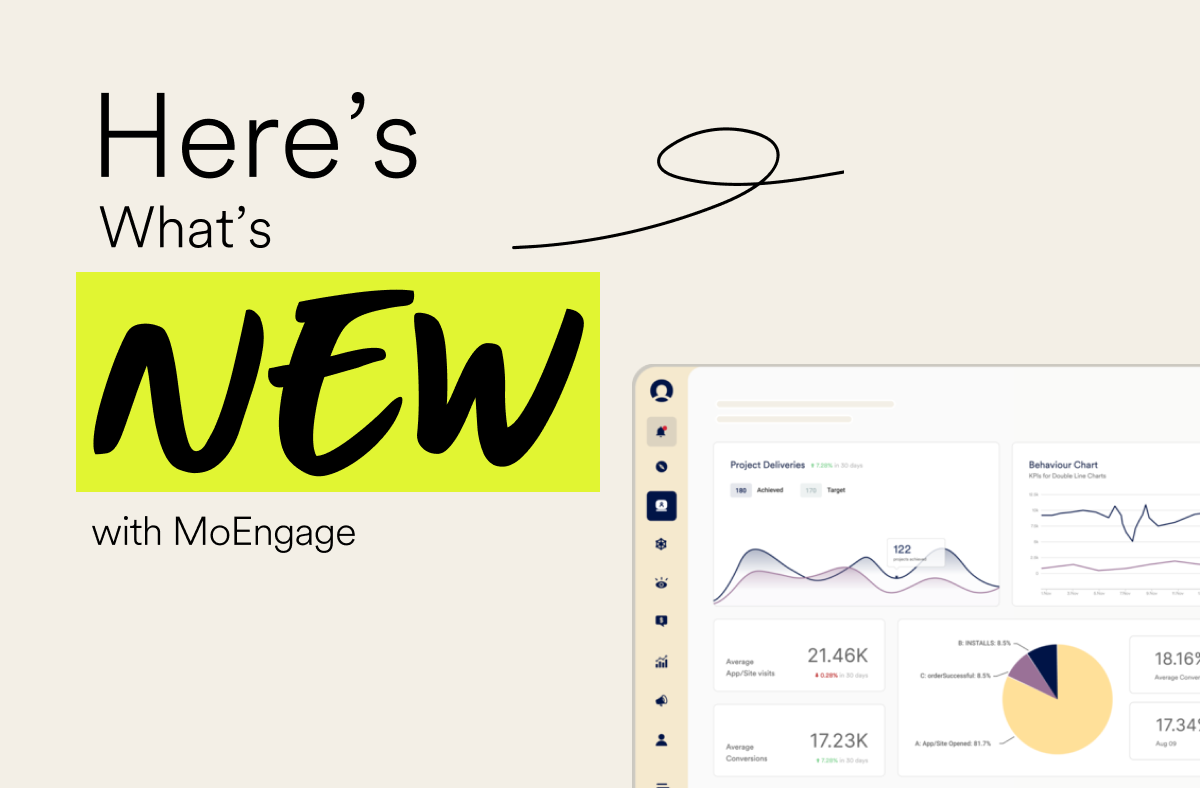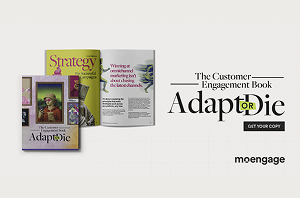Drip Email Software: The Ultimate Pricing and Buying Guide
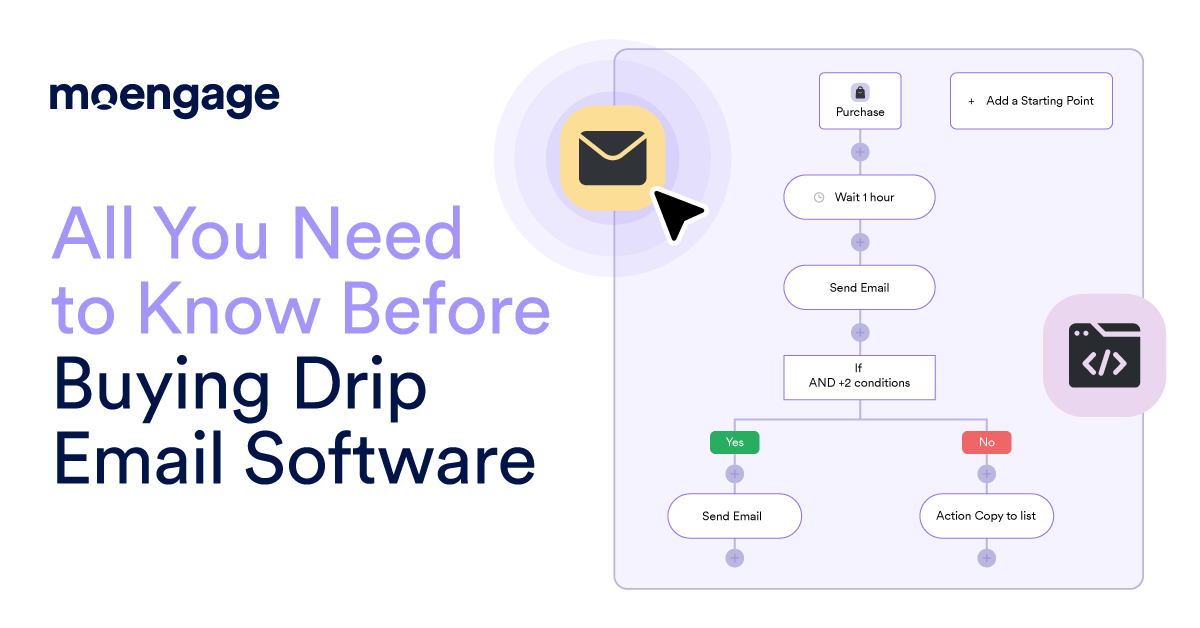
Reading Time: 11 minutes
Choosing the right drip email software can be a game-changer for your marketing strategy. With a variety of options available, understanding the pricing models and features each tool offers is key to making an informed decision.
In this guide, we’ll walk you through essential factors to consider when evaluating pricing, so you can select the best solution that fits your needs and budget for your drip email campaigns.
Ready to dive deeper? Let’s explore your options.
What Does Drip Email Marketing Software Cost?
Drip email marketing software typically follows a few different pricing models, depending on the provider. Here’s a quick breakdown of the most common ones:
- Pricing Based on MAUs (Monthly Active Users): You pay based on how many unique subscribers actually engage with your emails (or your system) each month, not your entire list size. It’s a much fairer, scalable way to pay, especially if your audience fluctuates. You only pay for real activity.
- Flat-Rate Pricing: You pay a fixed monthly fee, regardless of usage, list size, or activity. But flat rates are often bloated to cover all usage types, so you’re likely overpaying if you’re not sending a massive volume of emails. It’s not cost-efficient for scaling brands.
- List-Based Pricing: You pay based on the total number of contacts in your database, whether they engage or not. However, you end up paying for cold leads, dead emails, and inactive contacts. This makes your costs climb unnecessarily as your list grows.
- Email Volume-Based Pricing: You’re charged based on how many emails you send each month. It can discourage you from running important nurturing campaigns or re-engagement flows because every email adds to your bill. It’s unpredictable and can spike costs during promotions. For email marketers, this model means added pressure to limit sends, often at the cost of customer experience and long-term engagement.
Some platforms even bundle unnecessary features into expensive tiers, which bloats the pricing, especially for features you may not actually need. This is where MoEngage stands out. The platform offers a more transparent and scalable approach so that pricing is aligned to your actual usage and outcomes rather than inflated send limits.
6 Biggest Factors that Affect Drip Email Pricing
Drip email pricing depends on several factors. Here are some of the biggest ones:
1. Number of active contacts
Some platforms, particularly the ones that use the MAU pricing model, charge based on the number of customers who interact with your emails. The higher the number of active customers, the higher the pricing.
2. List size
Managing an email list is easier said than done. Nevertheless, if you have a large database of contacts, you will be charged a higher monthly fee. In this case, pricing will remain the same even if you don’t have many active subscribers on your list.
3. Email volume
The number of emails you send plays a big role in pricing. This is because high-volume automated email marketing campaigns require significant infrastructure for email delivery, tracking, and reporting.
4. Advanced features
Platforms offering advanced features like RFM segmentation, automation, A/B testing, analytics, and AI-driven personalization typically charge more than others. Some pricing models allow you to opt for some or all of these features, depending on your business requirements.
5. Automation complexity
If your drip campaign involves complex workflows, like different stages, conditions, triggers, etc., it can impact the pricing. Automation requires more resources to set up and maintain, which increases the price.
6. Integration with other tools
Connecting your email platform with CRMs, Ecommerce tools, or analytics systems can drive up costs, especially if platforms charge extra for native integrations or require third-party connectors.
Before signing up, ask yourself: how many of these tools are truly essential? Can any be replaced with ones that integrate more easily? A cluttered tech stack not only costs more but also complicates your workflows.
Top Features to Look For in a Drip Email Marketing Software
Since you’re on the lookout for a drip email marketing software platform, focus on the features we’ve mentioned below.
Core features that drip email software absolutely needs
These features are the must-haves. They are the foundational tools required to automate, personalize, and optimize your email drip campaigns at scale.
- Journey designer: Easily set up multi-step workflows triggered by parameters like customer actions, behaviors, or time delays with minimal coding.
- Behavioral targeting: Send emails based on real-time customer behavior, such as cart additions, subscriptions, app activity, and more, for highly relevant messaging.
- Personalization engine: Dynamically include customer attributes based on past interactions and preferences to personalize emails at scale.
- High inbox deliverability: Tools and practices that ensure you have a healthy sender reputation and high inbox placement.
- Campaign optimization with A/B testing: Test different email versions to learn what drives higher engagement and optimize your drip flows continuously.
- Real-time analytics and insights: Access detailed reports and dashboards that track key drip email marketing metrics like opens, clicks, and conversions, and identify drop-offs in your drip journeys.
Other features that are very useful to have
These features aren’t absolutely necessary to run an effective campaign, but they can improve customer experience and operational efficiency.
- AI-based predictive segmentation: Leverage AI to predict customer behavior like churn or likelihood of conversion, and automatically adjust campaigns accordingly.
- Omnichannel messaging: Integrate messaging across various channels, like push notifications, SMS, WhatsApp, and in-app messaging for a cohesive customer journey.
- Pre-built templates: Quickly access pre-built, customizable email templates to launch campaigns faster without heavy design work.
9 Steps to Choosing a Drip Email Marketing Software
With so many options available in the market, choosing the right drip email marketing software can seem like an uphill battle.
No worries! We’ll even walk you through exactly how to evaluate and compare drip email tools for yourself.
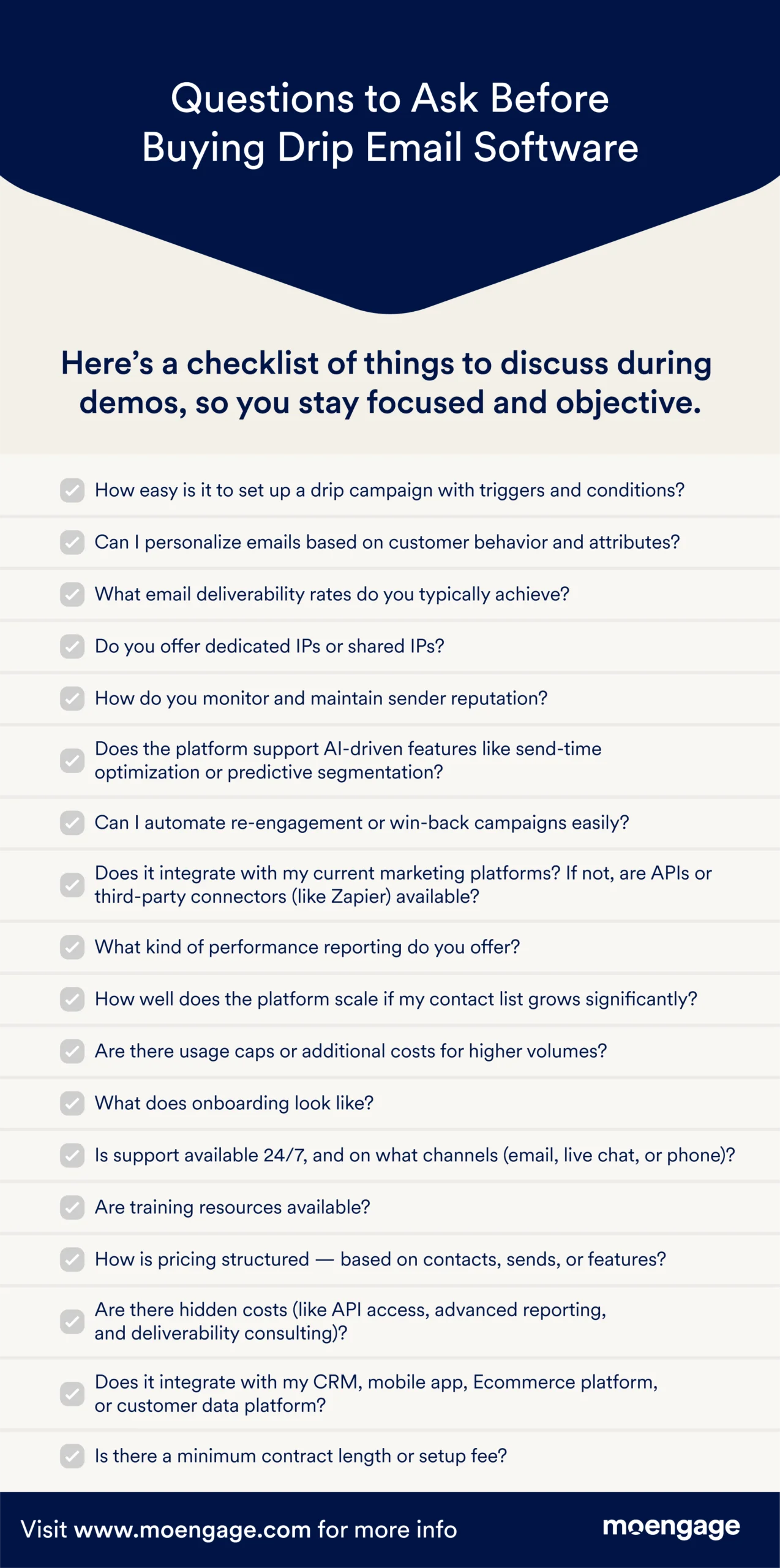
Once you’ve asked the right questions and gathered the facts during demos, it’s time to break down your decision-making process into clear, actionable steps.
Step 1: Define Your Non-Negotiable Features
The first step is to make a list of all the features that are necessary for you.
For example, if your goal is to send behavior-triggered drip campaigns (like abandoned cart emails or re-engagement nudges), then features like behavioral targeting and multi-step customer journey automation are non-negotiable. On the other hand, if you only need basic scheduled newsletters, you might not need advanced workflow builders or AI recommendations.
Once you have a list of non-negotiable features, it becomes easier to narrow down your platform choices.
Step 2: Research and Compare All Viable Options
Don’t just go with the most well-known or even the most affordable-looking tool. Research platforms that fit your business size and industry.
Use peer reviews, comparison guides, and case studies to understand how the platform performs in real-world use cases.
Also, remember that low entry pricing can be misleading. What matters is the total cost of ownership. Look for things like hidden fees, integration costs, or feature-based tier upgrades. These will add to the pricing later.
Step 3: Book a Personalized Demo (and Demand Proof)
When choosing your drip email marketing tool, make sure you request a personalized demo based on your business context, use cases, and workflows.
A simple, generic walkthrough isn’t helpful because this is your first real glimpse into how the platform is going to support you long-term. If the demo isn’t tailored to your business, that’s a red flag—because if they can’t offer personalized attention when they’re trying to win your business, you’re unlikely to get it during onboarding or implementation.
Ask to see features live, rather than just screenshots or slide decks. If a feature is critical, ask to see it in action. At times, sales teams may promise features that are still ‘in development’.
Step 4: Attend the Demo with a List of Questions
Once you’ve booked a demo, prepare a checklist of questions, like the one we shared above. This will help you stay focused and gain the clarity you need.
Ask whether the features you care about are included in the base plan or locked behind premium tiers. Dig into pricing: will the costs scale predictably as you grow, or are there hidden fees that only show up later?
Some platforms may offer attractive deals upfront but raise prices later or charge extra for essentials like API access, automation workflows, or deliverability support. The demo is your chance to surface all of this before signing anything.
Step 5: Evaluate Ease of Use
The drip email software you choose must be easy to use. Since marketers with little to no technical knowledge are most likely to use the platform, look for solutions that allow you to build email campaigns, segment audiences, and personalize messages easily.
Say no to complicated or clunky interfaces that are not intuitive and require a steep learning curve.
Step 6: Check for Advanced Capabilities
Ask about AI features like predictive segmentation or email send-time optimization. Even if you don’t need them right now, having future-ready capabilities ensures you won’t outgrow the tool too soon.
Step 7: Test for Scalability and Deliverability
This is an important one. Look for solutions that can handle large volumes of emails with good email deliverability rates. Make sure the software you choose has a high inbox placement rate. Check if they have a solid infrastructure and dedicated IPs, should you need them. Also, consider scalability: will this platform still meet your needs when your contact list grows from 10,000 to 100,000? Make sure you’re not locked into expensive pricing jumps or performance bottlenecks.
Step 8: Review Integration Options
Make sure the tool you choose fits seamlessly into your existing workflow. It should integrate with your CRM, mobile app, Ecommerce system, and anything else in your ecosystem.
Even if it doesn’t directly integrate, ensure that it offers flexible APIs and webhooks, or supports third-party connectors like Zapier, so you can still automate data flow without manual workarounds.
Step 9: Compare Customer Support Quality
Good software with bad support can be a nightmare. Check for onboarding help, technical support, availability, account management, and resources. Ask about how quickly the support team responds and resolves software issues to ensure that you have minimal downtime.
5 Best Email Drip Campaign Software and Tools
It’s time to weigh your options in choosing an email drip campaign software for your business. Give this list a quick read!
1. MoEngage: Best for Omnichannel Engagement and Behavioral Targeting
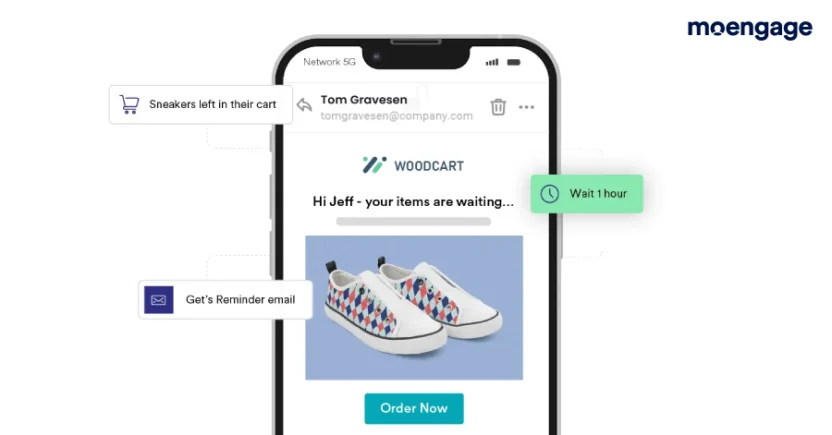
MoEngage is a comprehensive customer engagement platform designed to deliver personalized and automated drip email campaigns at scale. Its powerful AI capabilities allow you to use behavioral targeting to reach customers at the right time with the right message at different stages of their customer journey.
Why MoEngage is Best for Omnichannel Engagement and Behavioral Targeting: MoEngage offers multiple features that allow you to provide cohesive customer experiences across various touchpoints. You can reach out to customers via not just email, but also SMS, push notifications, in-app messages, and even ad networks without missing a beat.
Features like advanced segmentation enable you to send hyper-personalized drip email campaigns tailored to individual customer actions, such as cart abandonment or inactivity. This ensures that messages are timely, relevant, and effective in driving engagement.
How Pricing Works: MoEngage offers flexible drip email pricing based on the scale of your business and the exact features you’d need. You can always reach out to their sales team to learn more about their custom pricing plans.
How to Set Up a Demo: To experience MoEngage firsthand, you need to book a demo first. Their team will then contact you to schedule a personalized walkthrough that showcases how the platform can meet your specific drip email marketing goals.
2. ActiveCampaign: Best for Email and Marketing Automation
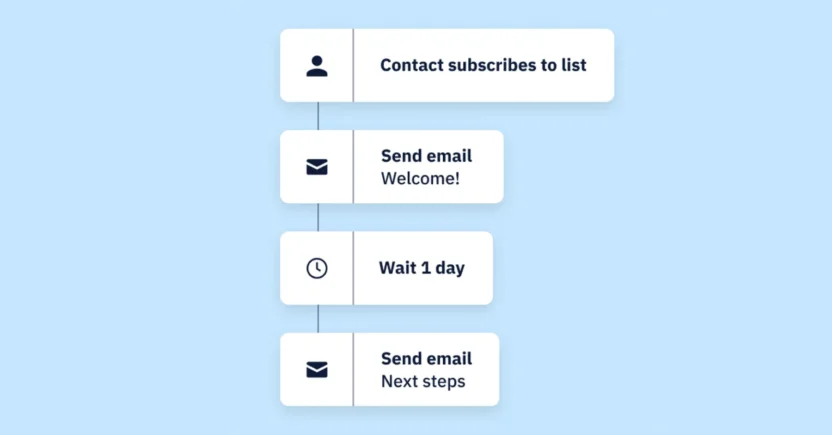
ActiveCampaign is a marketing automation platform that allows you to create email campaigns on channels your customers connect with. The platform offers predictive content features that help you show customers the most meaningful content.
Why ActiveCampaign is Best for Email and Marketing Automation: ActiveCampaign excels in delivering sophisticated automation campaign workflows that can be tailored to various customer journeys.
How Pricing Works: ActiveCampaign offers a four-tiered drip email pricing plan. The basic plan starts at $15/month for 1K contacts, while the Enterprise plan starts at $1,169/month for 50K contacts. If you have contacts upwards of that number, you need to talk to their sales team.
3. Kit: Best for Creators Using Emails
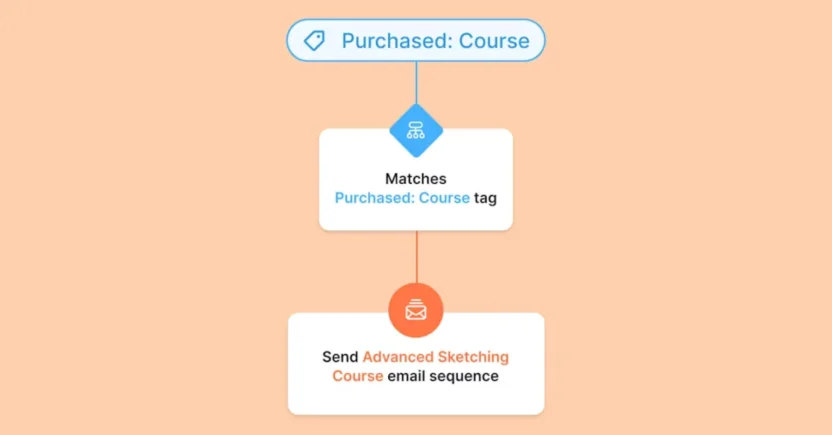
Kit is tailored for creators, bloggers, and solo entrepreneurs who want to send customer relationship emails. It offers a user-friendly interface with powerful automation capabilities.
Why Kit is Best for Creators and Solo Entrepreneurs: Kit’s email-first operating system allows creators to build long-term connections with customers. Its intuitive email designer can be used to create effective on-brand emails that are optimized for deliverability. Plus, it allows you to send email broadcasts for announcing product launches, sharing content updates, or promoting limited-time offers to your entire list in bulk.
How Pricing Works: Kit offers a free Newsletter plan with basic features like visual automation, opt-in forms, and email broadcasts to up to 10K subscribers. But you can implement just 1 visual automation and an email sequence on the free plan. Advanced plans start at $25 per month for up to 1K subscribers, and go up to $2,166/month for 400K contacts.
4. Drip: Best for Ecommerce Marketing Automation
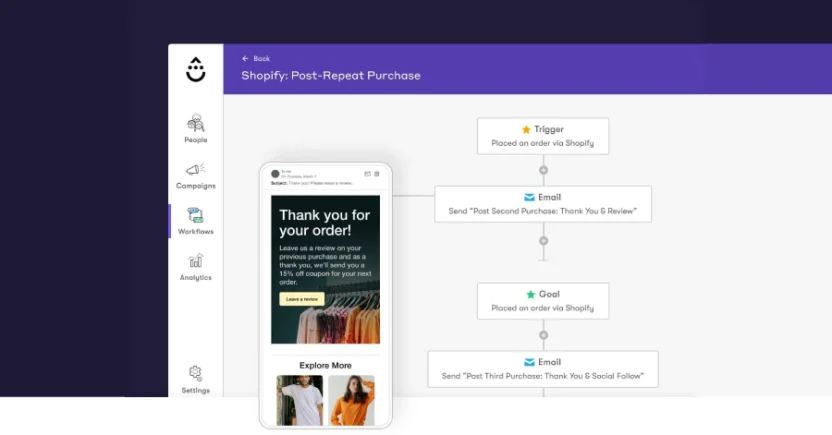
Drip is a marketing automation platform designed specifically for Ecommerce brands. It offers tools to create personalized email campaigns that drive customer engagement and sales.
Why Drip is Best for Ecommerce Marketing Automation: Drip provides deep integrations with Ecommerce platforms, allowing businesses to leverage customer data for targeted campaigns. Features like behavior-based automation and pre-built workflows help in crafting effective drip campaigns.
How Pricing Works: Drip’s pricing starts at $39/month for up to 2,500 contacts. The cost scales up to $1,999/month based on the number of contacts, with custom pricing available for larger lists of over 180K subscribers.
5. Mailmodo: Best for Interactive Email Marketing
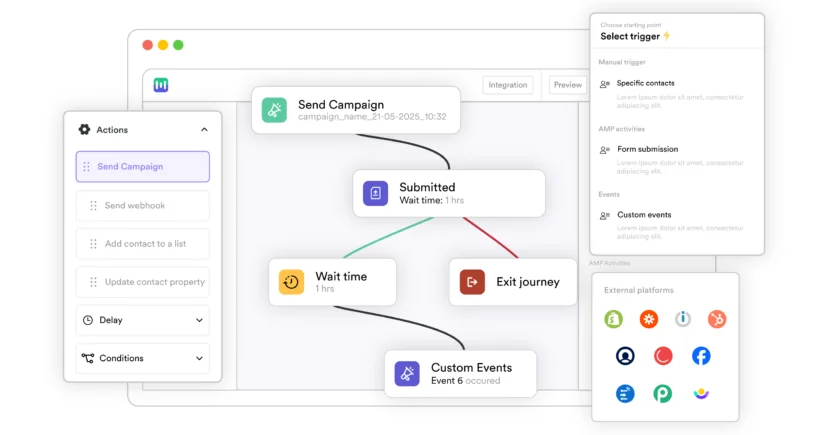
Mailmodo is an email marketing platform that enables the creation of interactive drip emails using AMP technology. This allows recipients to take actions like filling out forms or booking appointments directly within the email.
Why Mailmodo is Best for Interactive Email Marketing: Mailmodo stands out by offering interactive email capabilities that enhance customer engagement and conversion rates. Its drag-and-drop editor simplifies the creation of dynamic emails without any coding required.
How Pricing Works: Like the other drip email marketing software on this list, Mailmodo’s pricing is based on the number of contacts and emails sent per month. Its three-tiered pricing model starts at $39/month for 500 contacts, going up to $939/month for 250K subscribers. Any more contacts, and you have to reach out to their sales team.
How to Get the Most Value Out of Your Drip Email Software
Here are some of the ways in which you can leverage your drip email software to its maximum potential.
- Save time through automation: Automate welcome emails, follow-ups, and re-engagement campaigns to free up your team for more strategic work.
- Boost engagement with timely messaging: Set up triggers so that emails are automatically sent based on customers’ actions. This keeps your audience interested at every stage of their customer journey.
- Drive higher conversions with targeted sequences: Send the right email at the right time to move leads through the sales funnel towards a conversion.
- Personalize customer experiences at scale: Use segmentation and dynamic content to create a personalized customer experience without manually customizing every email.
- Continuously optimize with data-driven insights: Track performance metrics like open rates and conversions to refine your drip email campaigns and maximize results over time.
Maximize Engagement With MoEngage’s Drip Email Marketing Software
To sum it up, drip email marketing can be quite powerful for engaging customers at different stages of their journey.
Having the right drip email software in your tech stack ensures smooth, efficient workflows. Your team can focus on higher-value tasks while automating routine processes. It also ensures that your drip emails always reach the right person with the right message at the perfect time.
MoEngage’s powerful email automation platform allows you to automate personalized campaigns that drive higher engagement and conversions. With advanced segmentation, behavior-triggered messaging, and seamless integration with your ecosystem, you can nurture relationships more effectively than ever.
Curious to see how MoEngage can elevate your campaigns? Schedule a discovery call today.

